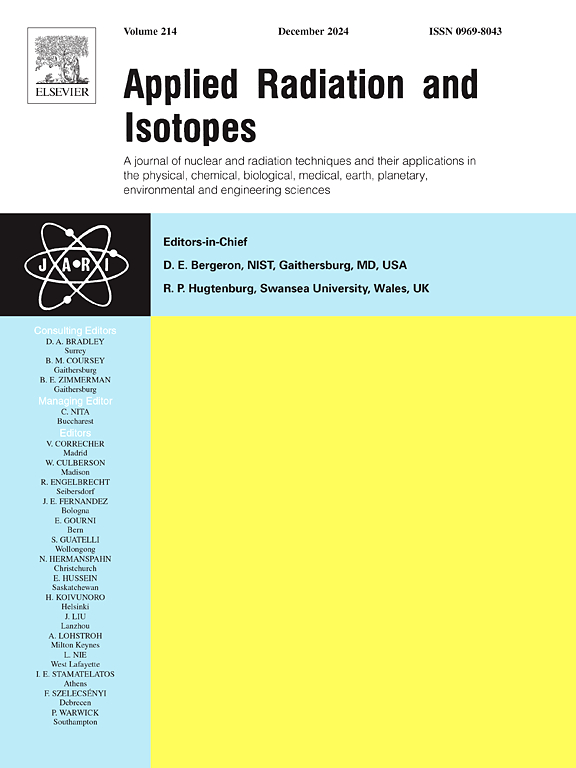介入性心脏科手术中基于持续剂量监测的病人协助方案
IF 1.8
3区 工程技术
Q3 CHEMISTRY, INORGANIC & NUCLEAR
引用次数: 0
摘要
我们的目的是提出一种监测方案,旨在根据2018年至2022年收集的数据库,帮助接受辐射剂量有皮肤损伤潜力的患者。该数据库可以识别这些患者,并使工作人员了解诊断参考水平(DRL)。当检查结束时记录实际辐射剂量水平(SRDL),累积空气克玛值等于或大于5 Gy或面积-空气克玛积(PKA)≥500 Gy时,确定患者随访。在10,176例手术的样本中,包括诊断(65 - 72% CA),经皮冠状动脉介入治疗(12 - 15% PCI)和CA后PCI(13 - 21%临时血管成形术),51例患者被确定为接受SRDL(0.52%的手术),并被归类为超重或肥胖。通过面对面预约或照射皮肤区域的照片对这些患者进行了持续监测。保持与每位患者的接触,一旦发现病变,患者将被转介到皮肤科进行治疗。在确定的53例手术中,42例患者正在积极随访(3例患者接受了2例手术,6例因心脏病死亡,2例未接电话)。8例出现不同程度皮肤损伤的患者,其中3名女性,转至皮肤科进行评估并进行临床随访。有可能保持积极的病人监测,为他们提供帮助,并鼓励工作人员优化放射防护。本文章由计算机程序翻译,如有差异,请以英文原文为准。

Patient assistance protocol based on continuous dose monitoring in interventional cardiological procedures
Our purpose is to present a monitoring protocol designed to assist patients who received radiation doses with skin damage potential based on a database collected from 2018 to 2022. This database allowed these patients to be identified and also enabled the staff to become aware of diagnostic reference level (DRL). The patients' follow-up was established when Substantial Radiation Dose Level (SRDL) was registered at the end of the exam in which cumulative air kerma values are equal to or greater than 5 Gy or area-air kerma product (PKA) ≥500 Gy.cm2 or fluoroscopy time ≥60 min. Among sample of 10,176 performed procedures including diagnostic (65–72 % CA), percutaneous coronary interventions (12–15 % PCI) and CA followed by PCI (13–21 % ad hoc angioplasty), 51 patients were identified as having received SRDL (0.52 % of procedures) and classified as overweight or obese. Continuous monitoring of these patients has been carried out through face-to-face appointments or by photos of irradiated skin region. Contact with each patient has been maintained and whenever a lesion is identified, the patient is referred to the dermatology department for treatment. Among the 53 procedures identified, 42 patients are under active follow-up (3 patients underwent 2 procedures, 6 died due to heart disease and 2 haven't answered calls). 8 patients who presented some degree of skin injury, being 3 females, were referred to the dermatology team for evaluation and have been kept under clinical follow-up. It is possible to maintain active patient monitoring, offering them assistance and encouraging the staff to optimize radiological protection.
求助全文
通过发布文献求助,成功后即可免费获取论文全文。
去求助
来源期刊

Applied Radiation and Isotopes
工程技术-核科学技术
CiteScore
3.00
自引率
12.50%
发文量
406
审稿时长
13.5 months
期刊介绍:
Applied Radiation and Isotopes provides a high quality medium for the publication of substantial, original and scientific and technological papers on the development and peaceful application of nuclear, radiation and radionuclide techniques in chemistry, physics, biochemistry, biology, medicine, security, engineering and in the earth, planetary and environmental sciences, all including dosimetry. Nuclear techniques are defined in the broadest sense and both experimental and theoretical papers are welcome. They include the development and use of α- and β-particles, X-rays and γ-rays, neutrons and other nuclear particles and radiations from all sources, including radionuclides, synchrotron sources, cyclotrons and reactors and from the natural environment.
The journal aims to publish papers with significance to an international audience, containing substantial novelty and scientific impact. The Editors reserve the rights to reject, with or without external review, papers that do not meet these criteria.
Papers dealing with radiation processing, i.e., where radiation is used to bring about a biological, chemical or physical change in a material, should be directed to our sister journal Radiation Physics and Chemistry.
 求助内容:
求助内容: 应助结果提醒方式:
应助结果提醒方式:


